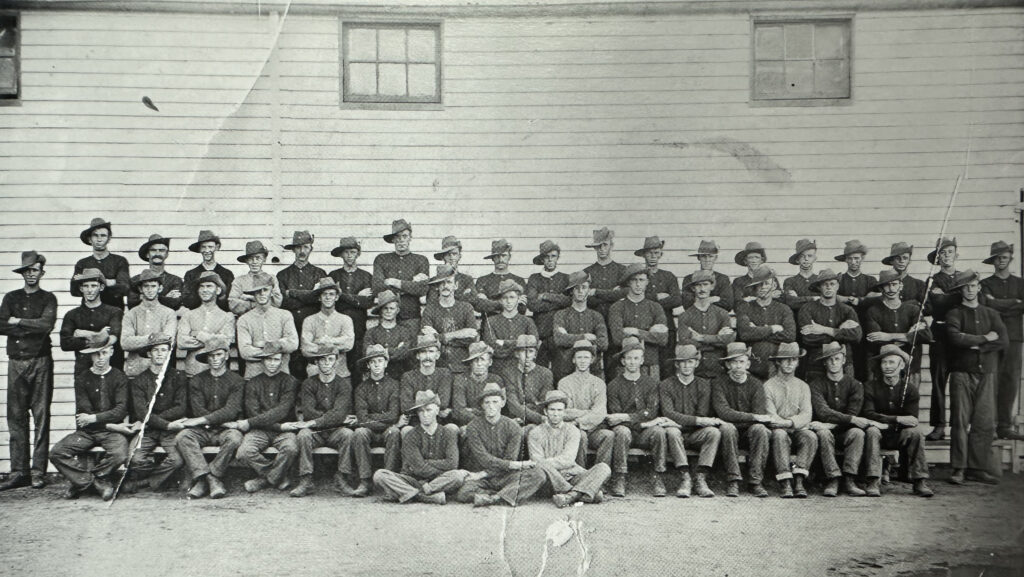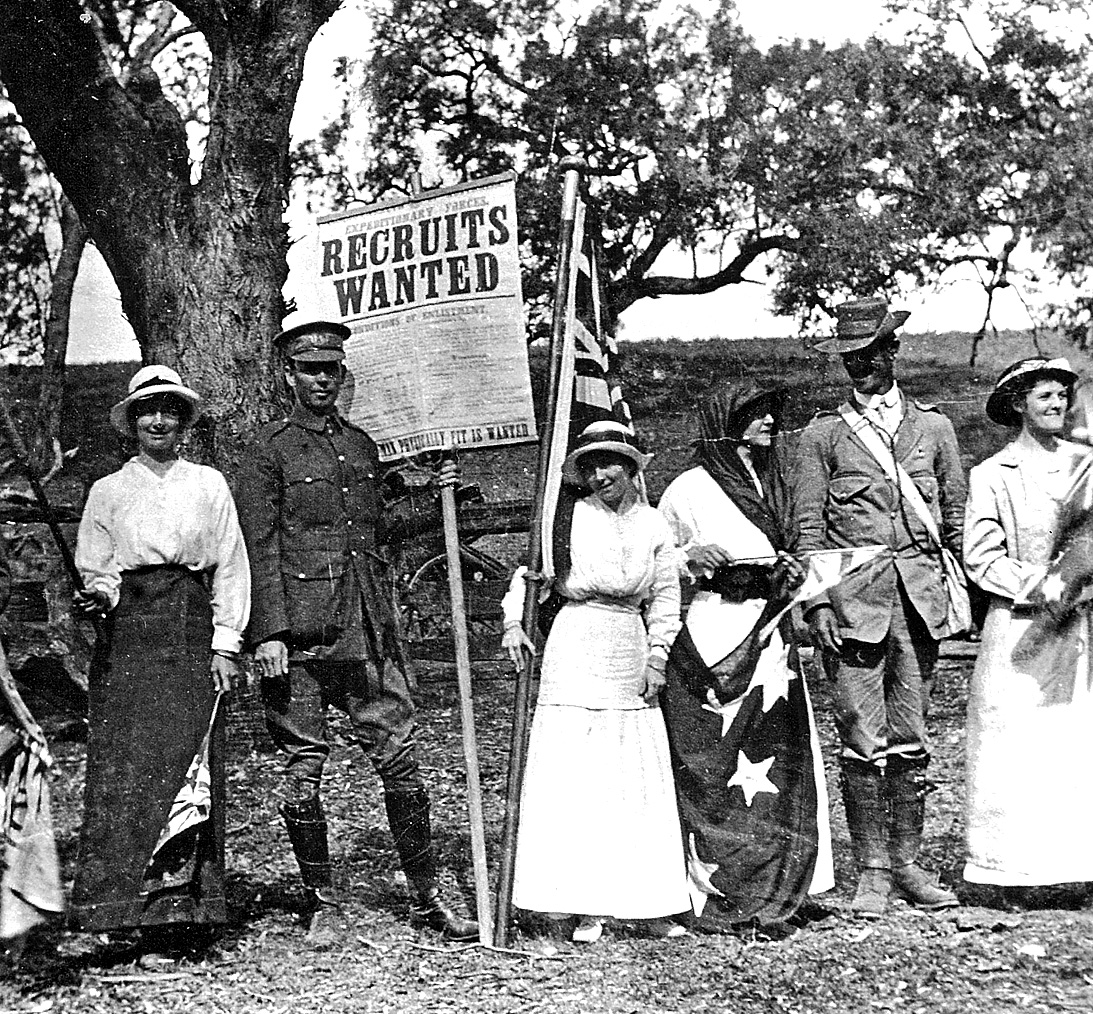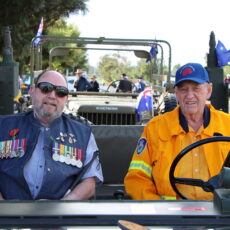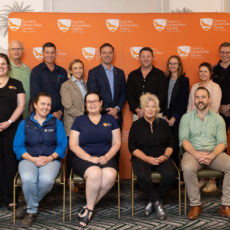Residents turned out in force in December 1915 to give a rousing welcome to the Wallabies, a band of young men marching from the North West to Newcastle to enlist for service in World War I.
To the beat of a kettle drum and the cheers of the crowds lining the streets in towns and villages, the Wallabies put their patriotism to the test and their lives on the line by signing up for the far-off battlefields.
The Wallaby March from Narrabri to Newcastle in December 1915 was an exciting event and became one of the most successful recruitment efforts of World War I, eventually providing around 800 troops for Australia’s war effort in Belgium and France and in Egypt and Palestine.
In Narrabri, Gunnedah, Quirindi, down through Coalfield towns in the Hunter Valley and villages in between, the steadily growing numbers of marchers were met by cheering crowds, brass bands and large numbers of excited youngsters.
The euphoria of the march, however, eventually gave way to despair as the Wallabies were pitched into battle on the killing fields of the Western Front.
Many of the Wallabies didn’t come back – the casualty lists were appalling – and many others carried the physical and emotional scars of war for the rest of their lives.
The Wallaby March came a few months after the highly successful Cooee March from Gilgandra in the central west to Sydney.
Volunteers from Wee Waa, Walgett, Collarenebri, Moree and Inverell districts began arriving by train and went into the Narrabri Military Camp on the racecourse near the railway station in early December 1915. After four days’ basic military training, the Wallabies assembled for an impressive parade in front of the Narrabri Town Hall on December 9 before they set off, accompanied to the edge of town by hundreds of enthusiastic friends and family, cars and buggies and children on foot and pushbikes. Spirits were high as the Wallabies took to the road out of the town, under the command of Captain Robert Cameron, of Pidgee Pidgee, Wee Waa, who was the President of the Namoi Shire Council at the time.
The men marched out behind a motor transport flying the Union Jack and the Australian flag, to the cheers of the crowd and the beat of a kettle drum, which had been presented to the group by citizens of the town.
Among the ranks of the marchers were shearers, opal miners, blacksmiths, clerks, stock and station agents, farmers, station hands, labourers, a grocer, school teachers, bank tellers and a clergyman, the Reverend John Wilkinson, Methodist Church minister at Narrabri, who became the Wallabies’ first casualty in early February 1916 – he was killed by a bolt of lightning while the Wallabies were in camp at West Maitland.
After leaving Narrabri, the marchers camped out the first night in a deluge of rain. By morning their blankets were like sponges.
Discarding their clothes, they marched on in their swimming costumes. By the time they arrived at Baan Baa, however, they were covered in mud, as the road was a quagmire.
As they entered each village, the men took up the chant – “what do we want?” Reply (a roar): “More men”. Each man was a recruiting agent. They sought out and “buttonholed” the young men, tried their hats on them and did their best to persuade them to join the march.
Each night the Wallabies bunked down in village halls and public buildings or, if they were out in the bush, they slept under the stars, using their Army issue coats rolled up into a swag as their pillow. As the march continued, publicity grew apace.

Narrabri was one of the largest enlistment centres in the North West in World War I, as well as the starting point for the Wallaby recruiting campaign.
At Boggabri the Wallabies were presented with two tambourines and at a public meeting that night the “star turn” was a permanently incapacitated local soldier, who described the landing at Gallipoli eight months earlier – how many brave Australian soldiers died as they hit the beach and in charging up the precipitous terrain against withering Turkish gunfire.
After the rally, the crowd converged on a local pub, where barrel after barrel of beer was drained. The publican wholeheartedly joined in the celebration and late in the night rolled an 18-gallon keg onto the footpath, calling out “fill ’em up boys, this one’s on the house”.
After the first rest day, on a Sunday, the march continued and as the Wallabies reached Gulligal they found a lorry load of cordials to quench their thirst and food and cakes supplied by the women of the district.
A sign, Welcome to the Wallabies, greeted them at Dubbledah Reserve and at Emerald Hill they were lavishly treated.
Tarpaulins had been spread on the ground and covered with snow-white tablecloths. The boys sat down to a splendid meal and at night there was a concert. Each recruit received a comfort parcel and a pipe.
One recruit was signed up at Dubbledah and two at Emerald Hill before the Wallabies set out for Gunnedah the next day.
After a few hours on the road, a parade near the freezing works pumphouse and a swim in the river, the recruits formed ranks for their triumphal march into Gunnedah.
The children of Rosewarne School, on the western outskirts of Gunnedah, were lined up on either side of the road – and there were more cakes and sandwiches before the marchers set out for Gunnedah.
The best description of the march comes from the notes of Gunnedah historian Russell McDonagh, published years later in the Namoi Independent newspaper.
It read, in part: “Long before the appointed time of arrival, throngs of people were assembling on the Boggabri Road. People in vehicles of all descriptions, men and women on horse-back, pedestrians of all ages, and schoolchildren, all went out to give the Wallabies a tumultuous welcome. It was estimated that there were nearly 2000 people congregated there.
“Led by Captain Cameron, the Wallabies were lustily singing patriotic songs to the accompaniment of the bagpipes and the rat-a-tat-tat of the kettle drum. A large banner was carried, which was most striking and fitting – it bore in large letters The North West Route March and underneath The Wallabies.
In an oval painting in the centre of the banner was a wallaby in its natural state.
“Twenty-two lads who had earlier been recruited at Gunnedah went out to join the Wallabies on the edge of town.
“On reaching the town boundary in the vicinity of the saleyards, a halt was called for the imposing procession through Conadilly Street, which was marshalled by Sergeant Reid of Gunnedah Police and headed by Constables Blackman and Prangley on police horses. Then followed the town band, the senior cadets under Sergeant Summers Reid, volunteer reserves, the militia led by Sergeant Cohen, the Rifle Club and the members of the Friendly Societies.
“On reaching the centre of the town, large streamers of bunting were suspended across the street and Allied flags were hung from the shops, hotels and public buildings.
“An outstanding feature was a large arch erected at the intersection of Conadilly and Marquis Streets. The Wallabies passed through the arch, which was constructed of willow greenery, with sheaves of wheat giving a fine effect to its base. It was festooned with coloured lighting and decorated with flags of the British and Allied nations as well as mottos of a patriotic nature. At the top was a painting of a wallaby bearing an Australian flag.
“Cheered and cheering, they swung along to Henry Street and the first halt was made at the convent for refreshments.
Between St Mary’s College and the Convent Primary School they passed through lines of children and spectators.
“Soon the young boarders of the college were dispensing refreshments to the recruits, under the supervision of Fathers Walsh P.P., Stephenson and Keane. Motor cars were later placed at the disposal of the recruits and they were taken for a swim in the Namoi”.
The Sydney Morning Herald, which had sent a reporter to cover the march, described the town’s welcome as “lavish”.
One of the spectators lining the route, a young man, called out: “Your feet will be sore before you get there, mate” to which one of the marchers replied: “It’s better to have sore feet than cold feet,” as much as saying that the caller should show some courage and throw in his lot with the Wallabies.
The procession down Conadilly Street was described by the Tamworth Daily Observer as the largest gathering in the town’s history, quoting Captain Cameron as saying that “the Governor-General could not have received a better reception”.
The Wallabies were later entertained in the open-air picture theatre but before recruiting speeches could be made, rain started to fall in torrents, everyone beating a retreat to the Oddfellows’ Hall.
Recruiting appeals were made and 10 new men were signed up with others promising to give their names after the Christ mas holidays. By the end of the evening a total of 40 recruits had been obtained, including the 22 who had signed up in Gunnedah before the arrival of the Wallabies, A highlight of the evening was the presentation of a live wallaby, a pet of Miss Una Pike, to Captain Cameron, to the accompaniment of loud cheering.
Following a night of heavy rain, the Wallabies set out for Curlewis. After a mile of hard slogging on the saturated road, the Wallabies took to the adjacent railway line to get around a particularly bad patch. Captain Cameron’s car became bogged three miles from Gunnedah, along with two other transport vehicles, all of which had to be pulled out of the mud by the transport horses.
Conditions were no better further along the road and the Wallabies had to return to the railway line for their entry to Curlewis about 4pm. There the Wallabies again received royal treatment. More than 20 lads gave their names and a similar number promised to join up at a later date.
The next day, some of the marchers were feeling the pinch and 30 men suffering from sore feet or strained sinews were taken by train to the next stop, Breeza, where the Wallabies were escorted into the village by members of the Breeza Rifle Club.
The Wallabies continued their march, steadily picking up recruits, they spent Christmas Day in Aberdeen and after reaching Maitland, they made a detour to the mining towns of Minmi, Kurri Kurri and Cessnock. On Saturday, January 8, the Wallabies reached their destination for a huge reception outside the Newcastle Town Hall.
The plan had been to continue the procession to Sydney by train, stopping for official receptions at Gosford, Wyong and Hornsby.
But other recruits from country areas rioted in Sydney over what they claimed were unrealistic training demands – rampaging through city hotels, vandalising business and public buildings and leaving a trail of looting and damage – and authorities decided instead to divide NSW into 12 military areas, with a training camp in each, which meant that no more country recruits would be trained in Sydney. So after 10 days encampment at Broadmeadow, the Wallabies were sent back to training camps at West Maitland and Maitland as a regional camp was established at Rutherford.
It was at Maitland Military Camp that the Wallabies suffered their first casualty, their popular chaplain, the Reverend (Private) John Wilkinson, who had been with the Wallabies from the start.
An Englishman, Reverend Wilkinson had endeared himself to the recruits, and as well as ministering to them, he had assumed responsibility for the medicine chest.
The Wallabies eventually formed the nucleus of the 34th Battalion of the AIF, which endured unimaginable conditions on the Western Front, sustaining terrible casualties. Among those who signed up at Gunnedah were Tom Torrens, Billy Richmond, Jack Dodd, Herb Pryor, Jack Bloomfield, Joe Stevens, Lance Tudgey, Pat Kelly, Fred and Jack Shaw, Dick Har-wood, Jim Panwick, Gerry Lonsdale, Fred Church, Vincent Wortley, Les Turner and William Dwyer. Many of these were killed.
The Menin Gate Memorial on the Western Front records the names of 54,000 Allied troops, who have no known grave, among them Leslie Turner, of Carroll, and Tom Torrens, of the small community of Rosewarne on the western outskirts of town. They died in the 34th Battalion’s assault on Messines Ridge on June 7, 1917, as did Curlewis soldier Robert George Sullivan, whose body was never found.
The Wallaby March created excitement in small towns where life was mostly uneventful and it inspired great patriotism.
The march was an adventure, the distant war beckoned.
So young men went off to war, fired with the ideals of defending the empire and driving off the invader. The realities of war, though, were much harsher.
On the Western Front, where most of the Wallabies ended up, life’s great adventure came to a shattering halt for so many.
To order photos from this page click here




